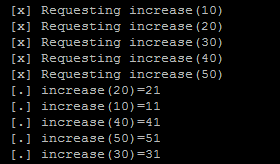python使用rabbitmq实例七,相互关联编号correlation id(7)
上一遍演示了远程结果返回的示例,但是有一个没有提到,就是correlation id,这个是个什么东东呢?
假设有多个计算节点,控制中心开启多个线程,往这些计算节点发送数字,要求计算结果并返回,但是控制中心只开启了一个队列,所有线程都是从这个队列里获取消息,每个线程如何确定收到的消息就是该线程对应的呢?这个就是correlation id的用处了。correlation翻译成中文就是相互关联,也表达了这个意思。
correlation id运行原理:控制中心发送计算请求时设置correlation id,而后计算节点将计算结果,连同接收到的correlation id一起返回,这样控制中心就能通过correlation id来标识请求。其实correlation id也可以理解为请求的唯一标识码。
示例内容:控制中心开启多个线程,每个线程都发起一次计算请求,通过correlation id,每个线程都能准确收到相应的计算结果。
compute.py代码分析
和上面一篇相比,只需修改一个地方:将计算结果发送回控制中心时,增加参数correlation_id的设定,该参数的值其实是从控制中心发送过来的,这里只是再次发送回去。代码如下:
1 |
#!/usr/bin/env python |
2 |
#coding=utf8 |
3 |
import pika |
4 |
5 |
#连接rabbitmq服务器 |
6 |
connection = pika.BlockingConnection(pika.ConnectionParameters( |
7 |
host='localhost')) |
8 |
channel = connection.channel() |
9 |
10 |
#定义队列 |
11 |
channel.queue_declare(queue='compute_queue') |
12 |
print ' [*] Waiting for n' |
13 |
14 |
#将n值加1 |
15 |
def increase(n): |
16 |
return n + 1 |
17 |
18 |
#定义接收到消息的处理方法 |
19 |
def request(ch, method, props, body): |
20 |
print " [.] increase(%s)" % (body,) |
21 |
22 |
response = increase(int(body)) |
23 |
24 |
#将计算结果发送回控制中心,增加correlation_id的设定 |
25 |
ch.basic_publish(exchange='', |
26 |
routing_key=props.reply_to, |
27 |
properties=pika.BasicProperties(correlation_id = \ |
28 |
props.correlation_id), |
29 |
body=str(response)) |
30 |
ch.basic_ack(delivery_tag = method.delivery_tag) |
31 |
32 |
channel.basic_qos(prefetch_count=1) |
33 |
channel.basic_consume(request, queue='compute_queue') |
34 |
35 |
channel.start_consuming() |
center.py代码分析
控制中心代码稍微复杂些,其中比较关键的有三个地方:
- 使用python的uuid来产生唯一的correlation_id。
- 发送计算请求时,设定参数correlation_id。
- 定义一个字典来保存返回的数据,并且键值为相应线程产生的correlation_id。
代码如下:
1 |
#!/usr/bin/env python |
2 |
#coding=utf8 |
3 |
import pika, threading, uuid |
4 |
5 |
#自定义线程类,继承threading.Thread |
6 |
class MyThread(threading.Thread): |
7 |
def __init__(self, func, num): |
8 |
super(MyThread, self).__init__() |
9 |
self.func = func |
10 |
self.num = num |
11 |
12 |
def run(self): |
13 |
print " [x] Requesting increase(%d)" % self.num |
14 |
response = self.func(self.num) |
15 |
print " [.] increase(%d)=%d" % (self.num, response) |
16 |
17 |
#控制中心类 |
18 |
class Center(object): |
19 |
def __init__(self): |
20 |
self.connection = pika.BlockingConnection(pika.ConnectionParameters( |
21 |
host='localhost')) |
22 |
23 |
self.channel = self.connection.channel() |
24 |
25 |
#定义接收返回消息的队列 |
26 |
result = self.channel.queue_declare(exclusive=True) |
27 |
self.callback_queue = result.method.queue |
28 |
29 |
self.channel.basic_consume(self.on_response, |
30 |
no_ack=True, |
31 |
queue=self.callback_queue) |
32 |
33 |
#返回的结果都会存储在该字典里 |
34 |
self.response = {} |
35 |
36 |
#定义接收到返回消息的处理方法 |
37 |
def on_response(self, ch, method, props, body): |
38 |
self.response[props.correlation_id] = body |
39 |
40 |
def request(self, n): |
41 |
corr_id = str(uuid.uuid4()) |
42 |
self.response[corr_id] = None |
43 |
44 |
#发送计算请求,并设定返回队列和correlation_id |
45 |
self.channel.basic_publish(exchange='', |
46 |
routing_key='compute_queue', |
47 |
properties=pika.BasicProperties( |
48 |
reply_to = self.callback_queue, |
49 |
correlation_id = corr_id, |
50 |
), |
51 |
body=str(n)) |
52 |
#接收返回的数据 |
53 |
while self.response[corr_id] is None: |
54 |
self.connection.process_data_events() |
55 |
return int(self.response[corr_id]) |
56 |
57 |
center = Center() |
58 |
#发起5次计算请求 |
59 |
nums= [10, 20, 30, 40 ,50] |
60 |
threads = [] |
61 |
for num in nums: |
62 |
threads.append(MyThread(center.request, num)) |
63 |
for thread in threads: |
64 |
thread.start() |
65 |
for thread in threads: |
66 |
thread.join() |
笔者开启了两个终端,来运行compute.py,开启一个终端来运行center.py,最后结果输出截图如下:
可以看到虽然获取的结果不是顺序输出,但是结果和源数据都是对应的。
这边示例的做法就是创建一个队列,使用correlation id来标识每次请求。也有做法可以不使用correlation id,就是每请求一次,就创建一个临时队列,不过这样太消耗性能了,官方也不推荐这么做。
